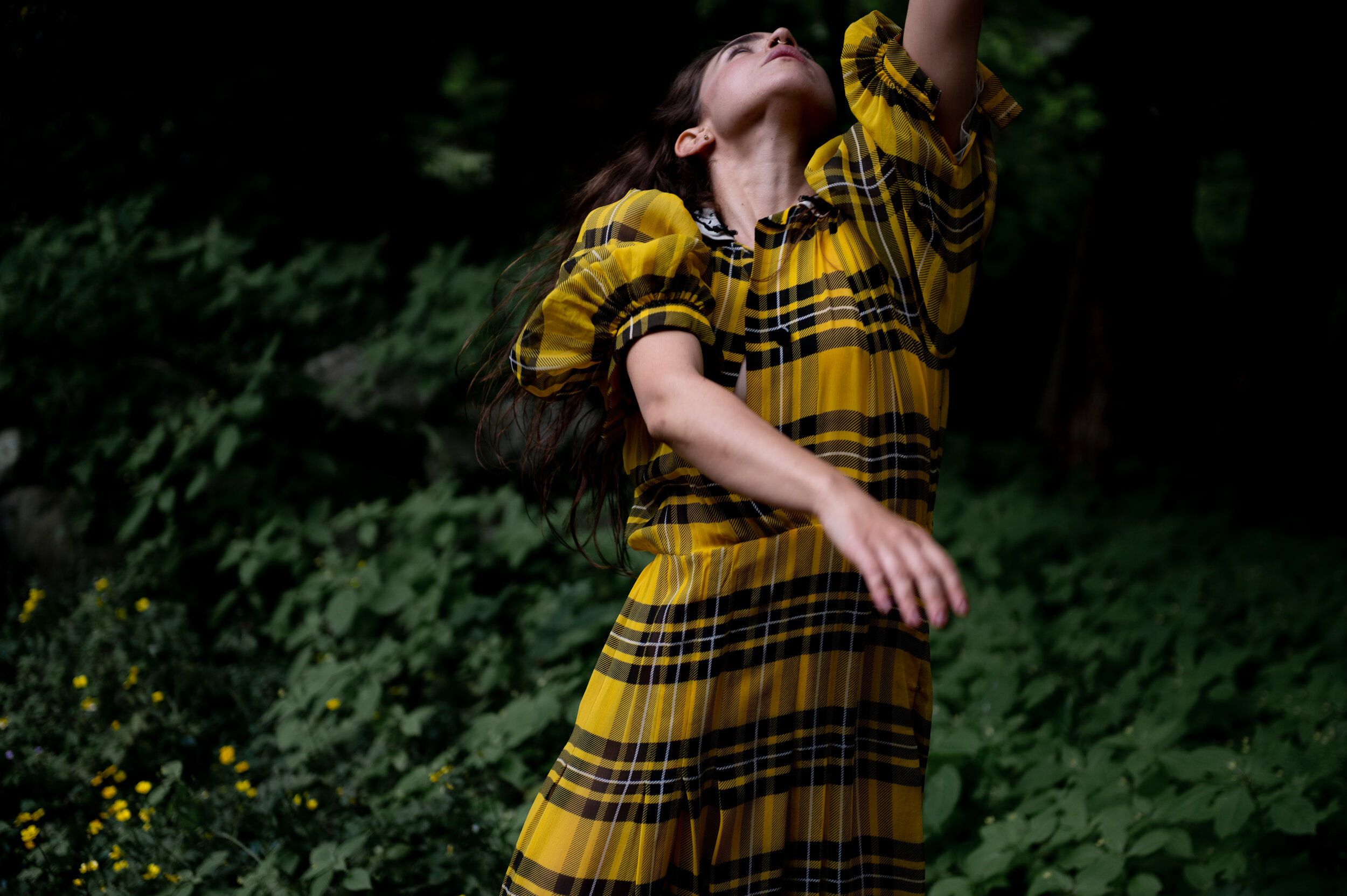Dance review: Dream logic and ballet-honed bodies, indoors and outdoors at Dancing on the Edge
Kirsten Wicklund bids an intense adieu to Vancouver audiences in Proof
_Kirsten Wicklund finds magic in a plaid dress in Proof. Photo by Cindi Wicklund Fotografia
THE DREAMLIKE and otherworldy combined Monday night at Dancing on the Edge—and not just because we were gathering for live performances for one of the first times in 16 surreal months.
Inside the Firehall Arts Centre, audiences caught two honed Ballet BC dancers: one a veteran who’s indicated she’s moving on in her career, and another representing the company’s new generation of talent.
Before her powerhouse and intensely personal solo Proof on Monday night, Kirsten Wicklund posted on social media that it would be her emotional last performance in Vancouver “for a while”. In her Edge bio, the locally raised dance artist who’s been a charismatic standout for seven seasons at Ballet BC indicated that she is relocating to Antwerp, Belgium to join the Opera Ballet Vlaanderen for its 2021/22 season. Their gain (and an exciting opportunity for her in an edgy European arts centre); our loss.
Her Proof showcased the fierce and muscular-yet-graceful style of the dancer, who’s been honing her choreographic skills for years. It also revealed a new side: her aptitude for spoken text.
The work was enigmatic, a sort of puzzlebox that could be read a number of different ways. Dressed in tight black shorts and tank top, with a gauzy plaid dress dangling on a hanger at one side of the stage, Wicklund reclined pensively on the floor. To the sound of a haunting, echoing electro score, she began asking an unseen force to teach her how to act, how to move—keenly listening, eager to learn, ready to work hard. After finding her feet and tapping her explosive power, she segued into the piece’s more serene second act, donning the dress and dancing to Angie McMahon’s soul-ripping rendition of Lana del Rey’s “Born to Die”.
The title of that song, and Wicklund’s accompanying poem in the program notes—which included the lines “If all I am is bones that swim/In skin with scars…”—hinted the work was about mortality. It alluded to our struggle to “prove” ourselves, to learn, to comply, and to fight onward, finally finding ourselves and following our inner voice. But it was hard not to see it, also, as a metaphor for the artistic struggle, particularly for the dancer who is moulded, shaped, and pushed to her limit, but finds her own expression within that.
It was one of those works that is mysterious but relatable at the same time—the arresting performer building to an emotional climax that expressed something difficult to put into words. Empowerment, agency, and the meaning of life, all got wrapped up into a pretty, magical yellow and black plaid dress—with Wicklund fearlessly committing to its physical and cathartic demands.
Kiana Jung in Initial Response and Reconfiguration.Photo by Cindi Wicklund.
The other half of the bill was Ballet BC veteran Peter Smida’s Initial Response and Reconfiguration, a highly experimental piece that paired two exciting talents: Kiana Jung, who joined Ballet BC as an emerging artist in 2019 and becomes a full-time company member in the upcoming season; and electroacoustic composer-performer Kimia Koochakzadeh-Yazdi, who manipulated a glowing keyboard under a spotlight, feeding, and feeding off of, the rhythms of the supercharged dancer.
Jung responded to the whirs, whistles, and other strange blurps and ripples that emanated as Koochakzadeh-Yazdi manipulated and warped the soundscape. At times it sounded as if metal raindrops were pounding a rooftop and echoing through the space; at others, huge whooshes pushed through the air—and seemingly through Jung’s body. Jung channelled the sound in dance that was by turns glitchy and contortive, with moments of virtuosic grace and balance. In a couple sequences, the noise appeared to push her over, and she arched her head and spine into a backwards “C”.
It was breathless watching smart and agile artists converse in new ways. Amid the otherworldly soundscape, there was also a sense of exploring the unknown.
A similar hallucinatory feeling was also evident at Dumb Instrument Dance’s Dreaming of Koi, staged outdoors at the Dr. Sun Yat-sen Classical Chinese Garden, when the shadows and sunlight of early evening make it an atmospheric, breeze-kissed oasis.
Dumb Instrument Dance’s Ziyian Kwan and Rianne Svelnis in Dreaming of Koi. Photo by David Cooper
Choreographer Ziyian Kwan performed with dancer Rianne Svelnis and taiko master Kage, as well as Juolin Lee and Junjie Wang, who were guides through the garden and took an active role in the piece. She played with the layered history of the site, and ideas around its manicured, human-made “wilderness”. In one scene, Kwan appeared out of a circular portal wearing a surreal, white tiger-head mask, alongside Svelnis in a leafy headpiece that obscurred her entire face. Later in the piece, Kwan growled and prowled around in a bear suit, while Svelnis transformed into a kind of flower monster bedecked in fake blooms. The vignettes followed their own dream logic.
The crux of the work was playing fake nature in the form of plastic flowers and butterflies off the natural rock forms and trees of the garden. But Dreaming of Koi was just as much about identity: at one point, Kwan grabbed a microphone and recalled the few words she remembers in Cantonese from her youth (phrases for tree, or for leaf). At another, holding up a big gold frame to create a portrait of themselves, the cast members each spoke their own mother tongue. The garden became a place for them, and us, to connect with a layered, complex past.
But mostly it was about whimsical, delerious imagery, conjured in carefully thought-out angles inside the ornate walls of a gorgeous garden. Not a bad way to spend a summer’s eve for a live-performance-starved audience who probably felt like they were dreaming.















